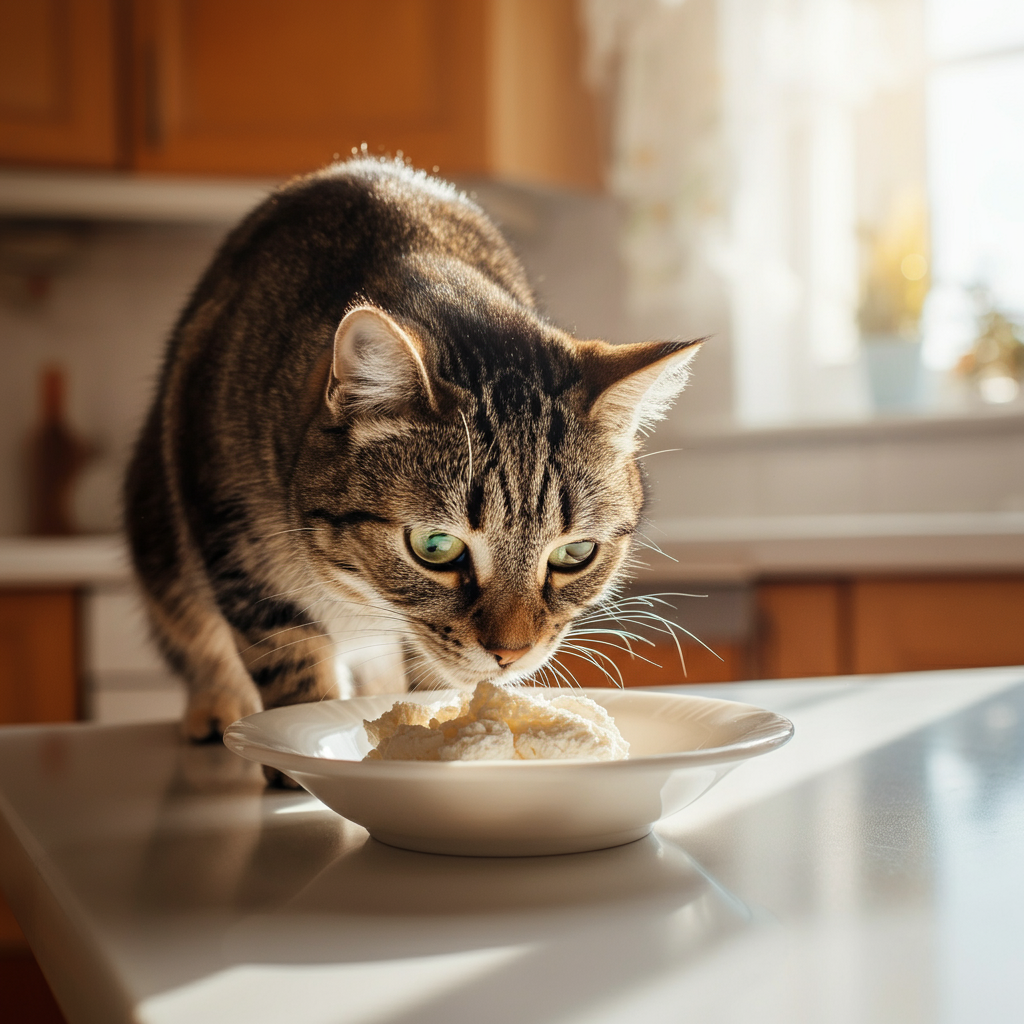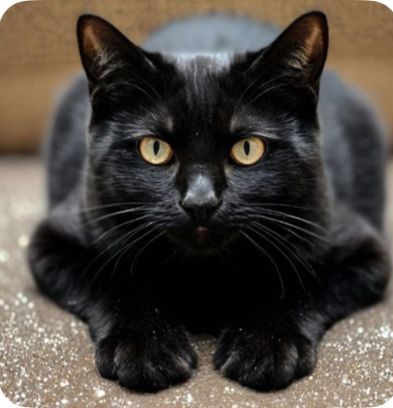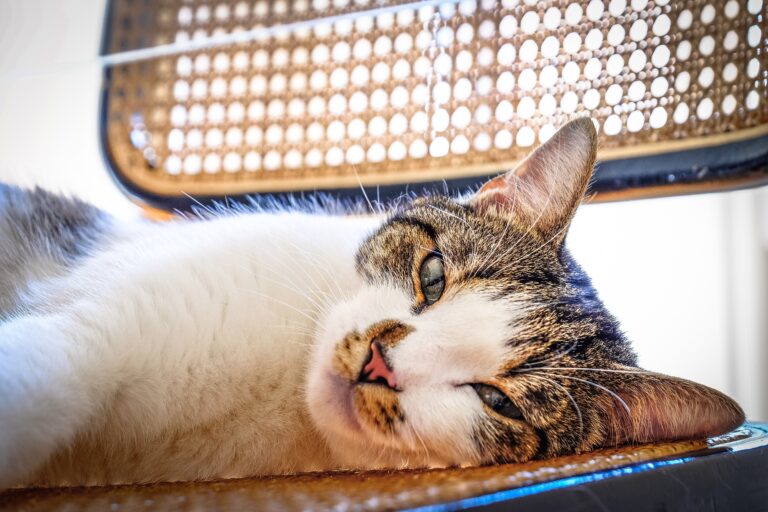Can Cats Eat Cream Cheese? The Complete Guide for Cat Parents
Can Cats eat cream cheese ? It is one of the most common question asked by cats owners even, Many cat owners find themselves wondering about the safety of everyday foods when their curious feline companions show interest in human snacks. Cream cheese, a popular breakfast staple and cooking ingredient, often catches cats’ attention with its creamy texture and mild aroma. While cream cheese isn’t toxic to cats, it’s far from an ideal treat for your furry friend.
Most cats are lactose intolerant, lacking the enzymes needed to properly digest dairy products like cream cheese. Additionally, cream cheese contains high levels of fat that can cause digestive upset and other health issues in cats. This comprehensive guide will explore why cream cheese poses risks for cats, what symptoms to watch for if your cat consumes it, and healthier alternatives that will keep your feline friend happy and healthy.
Understanding these dietary considerations is crucial for responsible pet ownership, helping you make informed decisions about what foods are safe to share with your beloved companion.
What is Cream Cheese?

Cream cheese is a soft, mild-tasting cheese made from a combination of cream and milk. The manufacturing process involves adding bacterial cultures to the dairy mixture, which creates the characteristic tangy flavor and smooth, spreadable texture that makes it popular for bagels, cheesecakes, and various recipes.
From a nutritional standpoint, cream cheese is primarily composed of fat and protein, with smaller amounts of carbohydrates in the form of lactose. A typical serving contains approximately 35% fat content, making it one of the higher-fat dairy products commonly found in households. The lactose content, while lower than that found in regular milk, still presents challenges for most cats’ digestive systems.
The protein content in cream cheese comes from casein and whey proteins naturally present in milk. While cats require protein in their diets, the type and concentration found in cream cheese isn’t optimal for feline nutrition. Cats are obligate carnivores, meaning their bodies are designed to process animal proteins from meat sources rather than dairy proteins.
Commercial cream cheese often contains additional ingredients such as stabilizers, preservatives, and sometimes salt, which can further complicate its suitability for cats. These additives serve to extend shelf life and maintain consistency but offer no nutritional benefits for felines and may even pose additional health risks.
Can Cats Eat Cream Cheese ?

Lactose Intolerance in Adult Cats
The primary concern with feeding cream cheese to cats stems from feline lactose intolerance. Kittens are born with the ability to produce lactase, the enzyme responsible for breaking down lactose found in their mother’s milk. However, as cats mature and are weaned, their production of lactase dramatically decreases.
By the time cats reach adulthood, most have lost the majority of their lactase-producing capability. This natural process occurs because cats, in their wild state, would no longer consume milk after weaning. Without adequate lactase enzymes, cats cannot properly digest lactose, leading to fermentation by intestinal bacteria and subsequent digestive distress.
When lactose passes through the digestive system undigested, it draws water into the intestines and undergoes bacterial fermentation. This process produces gas and organic acids, resulting in symptoms such as bloating, cramping, diarrhea, and general gastrointestinal discomfort.
Research indicates that approximately 90% of adult cats are lactose intolerant to some degree. While some cats may retain minimal lactase activity and show fewer symptoms, the vast majority will experience digestive upset when consuming dairy products like cream cheese.
High Fat Content Concerns
Beyond lactose intolerance, cream cheese poses additional risks due to its high fat content. Cats require a moderate amount of fat in their diets, but the concentration found in cream cheese far exceeds what’s appropriate for feline nutrition.
Excessive fat intake can lead to several health complications in cats. The most immediate concern is digestive upset, as cats’ systems aren’t designed to process large amounts of fat at once. This can result in loose stools, diarrhea, and abdominal discomfort.
Long-term consumption of high-fat foods like cream cheese can contribute to obesity in cats. Feline obesity is associated with numerous health problems, including diabetes, arthritis, heart disease, and reduced lifespan. Even occasional high-fat treats can contribute to weight gain over time.
Perhaps most seriously, sudden intake of high amounts of fat can trigger pancreatitis in susceptible cats. Pancreatitis is a potentially life-threatening condition involving inflammation of the pancreas. Symptoms include severe abdominal pain, vomiting, loss of appetite, and lethargy. Cats with a history of pancreatitis or those prone to the condition should strictly avoid high-fat foods.
Additional Digestive Concerns
The combination of lactose and high fat content creates a perfect storm for digestive problems in cats. Even cats that might tolerate small amounts of lactose may find the added burden of excess fat overwhelming for their digestive systems.
The texture and consistency of cream cheese can also pose challenges. Its thick, creamy nature may be difficult for some cats to process, potentially leading to regurgitation or vomiting. This is particularly concerning for cats that tend to eat quickly or have sensitive stomachs.
Some commercial cream cheese products contain additional ingredients that may not be suitable for cats. Salt content, while generally low in plain cream cheese, can still be problematic for cats with kidney issues or hypertension. Flavored varieties may contain ingredients like garlic or herbs that are toxic to cats.
Recognizing Symptoms of Cream Cheese Consumption
Understanding the signs of cream cheese consumption in cats is crucial for pet owners. Symptoms typically appear within a few hours of ingestion and can range from mild to severe depending on the amount consumed and the individual cat’s sensitivity.
Gastrointestinal Symptoms
The most common symptoms of cream cheese consumption relate to digestive upset. Diarrhea is perhaps the most frequent sign, occurring as undigested lactose draws water into the intestines. The severity can range from slightly loose stools to watery diarrhea that may lead to dehydration if prolonged.
Bloating and abdominal discomfort are also common symptoms. Cats may exhibit signs of pain such as hunched posture, reluctance to move, or sensitivity when the abdomen is touched. Gas production from bacterial fermentation of lactose can cause visible abdominal distension and audible stomach rumbling.
Vomiting may occur, though it’s less common than diarrhea with cream cheese consumption. When vomiting does happen, it typically occurs within the first few hours after consumption and may be related to the high fat content overwhelming the cat’s digestive system.
Changes in litter box habits are another indicator. Cats may have accidents outside the litter box due to urgency, or they may strain while attempting to defecate. Some cats may also show increased frequency of litter box visits.
Behavioral Changes
Cats experiencing digestive discomfort from cream cheese consumption often display behavioral changes. Lethargy is common as the cat’s energy is diverted to dealing with digestive upset. Affected cats may seem less active than usual and prefer to rest in quiet locations.
Loss of appetite frequently accompanies digestive symptoms. Cats may show disinterest in their regular food or treats. This is a natural protective mechanism as the body focuses on resolving the digestive disturbance.
Some cats may exhibit restlessness or apparent discomfort, moving frequently or having difficulty finding a comfortable position. This behavior often indicates abdominal cramping or pain associated with lactose fermentation.
When to Consult a Veterinarian
While most cases of cream cheese consumption result in mild, self-limiting symptoms, certain situations warrant veterinary attention. Severe or persistent diarrhea lasting more than 24 hours can lead to dehydration, particularly in kittens, senior cats, or cats with underlying health conditions.
Signs of dehydration include lethargy, dry gums, skin that doesn’t spring back quickly when gently pinched, and sunken eyes. Dehydrated cats require prompt veterinary care and may need fluid therapy to restore proper hydration levels.
Repeated vomiting, especially if the cat cannot keep water down, is another red flag requiring immediate veterinary attention. This can quickly lead to dehydration and electrolyte imbalances.
Any signs of severe abdominal pain, such as crying when touched, assuming unusual postures, or extreme lethargy, should prompt immediate veterinary consultation. These symptoms could indicate pancreatitis or other serious complications.
Cats with pre-existing health conditions, particularly diabetes, kidney disease, or a history of pancreatitis, should be monitored more closely and veterinary advice sought sooner rather than later.
Healthier Treat Alternatives for Cats
Rather than risking the potential problems associated with cream cheese, cat owners have numerous healthier alternatives that can satisfy their pet’s desire for special treats while supporting optimal feline nutrition.
Commercial Cat Treats
The pet food industry offers a wide variety of treats specifically formulated for cats’ nutritional needs. These products undergo safety testing and are designed to complement a balanced feline diet without causing digestive upset.
Freeze-dried meat treats are excellent options that align with cats’ carnivorous nature. Products made from chicken, turkey, salmon, or other high-quality proteins provide familiar flavors that most cats find irresistible. These treats are typically low in fat and free from dairy-related ingredients.
Crunchy dental treats serve a dual purpose by providing enjoyment while promoting oral health. Many of these products are designed to help reduce tartar buildup and freshen breath, making them beneficial additions to a cat’s routine.
Training treats, which are small and easily consumable, work well for cats that enjoy frequent small rewards. These treats are typically formulated to be nutritionally balanced even when given regularly.
Homemade Treat Options
For cat owners who prefer to control exactly what their pets consume, homemade treats offer an excellent alternative. Simple preparation methods can create healthy, appealing treats using cat-safe ingredients.
Cooked chicken breast, cut into small pieces and offered plain (without seasoning, oils, or marinades), makes an excellent high-protein treat. The meat should be fully cooked to eliminate any risk of bacterial contamination and cooled before serving.
Small pieces of cooked fish, such as salmon or tuna, can be offered occasionally. It’s important to ensure the fish is cooked thoroughly and contains no bones. Canned fish intended for human consumption should be avoided due to high sodium content.
Cooked egg, either scrambled without oil or hard-boiled, can provide a protein-rich treat that most cats enjoy. Eggs should always be fully cooked to prevent the risk of salmonella.
Natural Alternatives
Some cats enjoy certain vegetables or fruits in small quantities, though these should always be offered cautiously and in minimal amounts since cats are obligate carnivores.
Small pieces of cooked pumpkin (not pie filling) can be beneficial for cats with digestive issues and provide fiber. Many cats find the texture and mild flavor appealing.
Catnip, while not technically a treat in the traditional sense, can provide entertainment and enrichment for cats that respond to it. Fresh or dried catnip can be offered as a special experience.
Cat grass, which can be grown easily indoors, provides a natural source of enrichment and may aid digestion. Many cats instinctively seek out grass, making this a natural addition to their environment.
Expert Veterinary Perspectives
Veterinary professionals consistently advise against feeding dairy products like cream cheese to cats due to the well-documented risks and lack of nutritional benefits. Dr. Paola Cuevas, a veterinarian with over 18 years of experience, emphasizes that while cream cheese isn’t toxic, the lactose content can cause significant digestive distress in most cats.
Veterinary nutritionists point out that cats have evolved as obligate carnivores, meaning their digestive systems are optimized for processing meat-based proteins and fats rather than dairy products. The fat composition in cream cheese differs significantly from the fats cats would naturally consume, potentially leading to digestive complications.
Clinical studies on feline lactose intolerance support the recommendation to avoid dairy products. Research published in veterinary journals demonstrates that the majority of adult cats lack sufficient lactase enzyme activity to properly digest lactose-containing foods.
Veterinary professionals also highlight the importance of maintaining cats on nutritionally complete diets specifically formulated for their needs. Treats, including any human food offered to cats, should comprise no more than 10% of their daily caloric intake to prevent nutritional imbalances.
Many veterinarians report seeing cases of pancreatitis in cats following consumption of high-fat foods. While cream cheese alone may not cause this serious condition, it can contribute to the risk, particularly in cats with predisposing factors.
Understanding Different Types of Cheese and Cats
While this article focuses primarily on cream cheese, cat owners often wonder about other cheese varieties and their safety for feline consumption. Understanding how different cheeses affect cats can help owners make informed decisions about occasional treats.
String Cheese and Mozzarella
String cheese, typically made from mozzarella, contains similar lactose levels to cream cheese but generally has a lower fat content. However, the lactose intolerance issue remains the same, making it unsuitable for most cats. The stringy texture also poses a potential choking hazard, particularly for cats that tend to swallow food quickly.
Cottage Cheese
Cottage cheese contains lower fat levels compared to cream cheese but still presents lactose intolerance concerns. Some cat owners believe cottage cheese is safer due to its lower fat content, but the lactose content remains problematic for most felines. Additionally, cottage cheese often contains added salt, which can be harmful to cats with kidney or heart conditions.
Hard Cheeses
Aged hard cheeses like cheddar or parmesan contain lower lactose levels due to the aging process, which breaks down some lactose. However, these cheeses are typically higher in sodium and may contain other additives that aren’t suitable for cats. The harder texture can also present choking risks.
The Bottom Line on Cheese Varieties
Regardless of the type, all cheese products present similar risks for cats: lactose intolerance, high fat content, and potential for digestive upset. No cheese variety is considered safe or recommended for regular feline consumption.
Creating a Safe Feeding Environment
Preventing accidental cream cheese consumption requires thoughtful household management, particularly in homes where cats are curious about human food or have access to kitchen areas during meal preparation.
Food Storage Strategies
Proper food storage prevents opportunistic consumption. Cream cheese and other dairy products should be stored in closed containers within the refrigerator, preferably on higher shelves that cats cannot access. Many cats are skilled climbers and jumpers, so even elevated storage isn’t foolproof.
Counter safety becomes particularly important when preparing foods containing cream cheese. Cats should be supervised or removed from the kitchen during food preparation involving dairy products. Even small amounts left on utensils or cutting boards can be problematic if consumed.
Family Education
All household members should understand the risks associated with feeding cats dairy products. Children, in particular, may not realize that sharing their snacks with cats can cause health problems. Clear household rules about human food and pet feeding help prevent accidental exposure.
Guests and visitors should also be informed about dietary restrictions for household cats. Well-meaning visitors often want to share treats with pets but may not understand which foods are inappropriate.
Emergency Preparedness
Despite best prevention efforts, accidental consumption may still occur. Having a plan in place helps ensure appropriate response. Keep your veterinarian’s contact information easily accessible, along with after-hours emergency clinic details.
Know the signs that warrant immediate veterinary attention versus those that can be monitored at home. Having this information readily available prevents panic and ensures appropriate care timing.
Long-Term Health Considerations
While occasional small amounts of cream cheese may not cause lasting harm in healthy cats, repeated exposure can contribute to long-term health issues that extend beyond immediate digestive upset.
Weight Management
The high caloric density of cream cheese can contribute to weight gain over time, even with small portions. Feline obesity is a significant health concern that affects nearly 60% of pet cats in the United States. Overweight cats face increased risks of diabetes, arthritis, heart disease, and reduced lifespan.
Digestive Health
Repeated exposure to foods that cause digestive upset can potentially lead to chronic gastrointestinal sensitivities. Cats that regularly consume inappropriate foods may develop ongoing digestive issues that require veterinary management.
Nutritional Balance
Regular treats that don’t contribute to proper feline nutrition can impact overall dietary balance. Cats have specific nutritional requirements that are best met through high-quality commercial cat foods or properly balanced homemade diets formulated with veterinary guidance.
Prioritizing Your Cat’s Health Through Proper Nutrition
Understanding why cream cheese isn’t suitable for cats empowers pet owners to make better dietary decisions for their feline companions. While the immediate risks of small amounts may seem minimal, the potential for digestive upset, coupled with the lack of nutritional benefits, makes cream cheese an inappropriate treat choice.
The lactose intolerance prevalent in adult cats, combined with cream cheese’s high fat content, creates unnecessary health risks that can easily be avoided. Instead of sharing dairy-based human foods, focus on providing treats specifically designed for feline nutrition and digestive systems.
Remember that the best treats for cats are those that align with their carnivorous nature—high-quality protein sources that provide both enjoyment and nutritional value. Commercial cat treats, small pieces of cooked meat, or veterinary-recommended options offer safer alternatives that satisfy your cat’s desire for special foods without compromising their health.
When in doubt about any food’s safety for your cat, consult with your veterinarian. They can provide personalized advice based on your cat’s individual health status, age, and dietary needs, ensuring that treat time remains both enjoyable and safe for your beloved feline friend.






